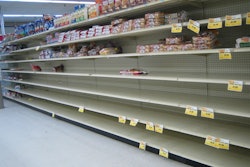
The cycle of Consumer Packaged Goods (CPG) retailing and marketing continues. Retailers compete and consolidate, while channels such as dollar stores and extreme value gain in importance. New products are launched, while long-time favorites fade away as a new shelf set is created. The shopper becomes more demanding and eager to change stores if displeased.
And through it all, the beat goes on for out-of-stocks (OOS), that traditional, much-studied and nettlesome problem. What is the final solution? Is there one?
Food Logistics has assembled a panel of experts to discuss the problem and latest solutions. They include:
- Thomas W. Gruen, Ph.D., professor of marketing, University of Colorado at Colorado Springs;
- Jack Haedicke, president, Arena Consulting Group, Minneapolis;
- Pamela Stegeman, vice president, supply chain and technology, Grocery Manufacturers Association (GMA), Washington;
- Chad Symens, president and CEO, Rainmaker Group, Akron, OH;
- Eric Togneri, principal, vice president, CPG solutions, Association of Category Development Professionals (CPG CatNet), Atlanta.
What companies are doing a good job of managing out-of-stocks?
Haedicke: Target is a good example. They have positive receiving, meaning they check in every SKU and have perpetual inventories in the store, netted against what scans through. That still is extremely rare. They know their inventory all the time and they can keep OOS fairly low. Wal-Mart and Meijer do it, but not many others. Also, Wal-Mart, Target and Meijer all ship to the store based on scan. They are so much better at fulfilling inventory because of what I think are very basic systems.
Why haven't more companies done this?
Haedicke: When CEOs have the opportunity to spend money on internal systems, build a new store, or put in a new merchandising strategy, they look at the top line instead of managing the bottom line. Cost matters, but having the systems to manage that cost is really important. These are not difficult things to do.
After so many years of studying the problem, there are still root causes of out-of-stocks that need to be addressed. What are they?
Gruen: There are three major issues: data accuracy, measurement and shelf merchandising practices. Data accuracy must be addressed first, as it is the foundation for ordering and forecasting. We found major problems with retailers' product item data accuracy. There are a host of reasons for product data inaccuracy and combined they cause a significant problem.
We have found measurement of OOS to be a major issue. Manual audits and perpetual inventory measurement of OOS levels are inaccurate, do not focus on the lost sales associated with an OOS item and do not adequately point to solutions. We identified a variety of store issues that create perpetual inventory (PI) system inaccuracy, where actual on-hand inventory did not match the inventory in the database. The level of PI inaccuracy was stunning, as PI accuracy (where the PI exactly matched the on-hands) ranged from 32 percent to 45 percent in the four studies we conducted or examined.
Shelf merchandising issues continue to be a major contributor to OOS. First, most OOS sales losses are due to a relatively small number of items. Few of these items have adequate shelf space relative to their demand. We found that 91 percent of the retailers' SKUs are allocated shelf space based on case pack-out and 86 percent of the inventory on shelf is in excess of seven days supply.
Symens: Many vendors only make in-stock improvement a priority if they receive a poor mark on their score card. Because in-stock percentages are most often viewed in aggregate across the entire retail chain, a vendor with a 98 percent in-stock percentage can be mislead into a false sense of security. The reality is that last 2 percent can represent hundreds of stores and a huge opportunity for improvement.
From a vendor's perspective, we see three barriers to tacking OOS: first, vendors need timely access to store- and item-level data; second, on-hand data provided by the retailer must be accurate; and third, vendors need the tools to quickly filter the data and create actionable plans.
Haedicke: In a traditional grocery environment, a buyer gets a bonus every quarter based on trade deal funding and inside margin. Inside margin is slotting. So you want to get as much slotting funds as possible, and the incentive is to add new items. They wind up getting too many SKUs which leads to a lot of OOS because you can't carry that much inventory in the warehouse. It's tough to keep track of.
That would require a radical change in commission procedures, wouldn't it?
Haedicke: Lee Scott of Wal-Mart made the decision 10 years ago to bonus these guys not on inside margin, but on net profitability. They will turn inventory quickly and only add SKUs that are needed. Plus, when manufacturers go to Wal-Mart, they don't want trade deal funding. They want net cost of goods and nothing else.
What new solutions can help reduce OOS?
Togneri: In the age of automatic replenishment, OOS is largely a product of the lack of store-level empowerment. Creating an environment where senior store-level employees are compensated in part upon store-level metrics like OOS (in addition to shrinkage, revenues, etc.) creates community-based-retailer GMs. This is critical to the success of every retail operation. OOS, in this framework, are addressed through a direct connection of incentives aligned with attention to detail.
To be certain, technological advancements in RFID will continue to increase the tools that will support issue recognition. But, ultimately someone needs to ensure correct item counts are maintained in systems, that product is merchandised in the manner dictated by shelf layout decisions and that unusual shopping patterns can be addressed quickly by store-level identification and adherence to correction procedures.
Technology and advanced analytics will give us the other tools to solve the problem, but the front lines of retail need to be actively engaged with a commitment to seeking solutions through intolerance for OOS.
Stegeman: Out-of-stocks are often a result of some form of miscommunication between manufacturers and retailers. By changing the way we work together, beginning with the sales call and our points of connection, we can minimize the supply chain disruptions that cause OOS.
At the 2006 GMA Executive Conference, Colleen Wegman and Tim Smucker presented a new vision for trading partner collaboration. Recognizing the potential value of developing shared strategies and working closely together to define joint goals and measures, they, along with Procter & Gamble, began pilots to prove this vision.
Titled New Ways of Working Together, this concept is a framework consisting of four strategic choices, which guide trading partner work plans, and two tracks, which define levels of interaction and sharing between companies and across the industry. The framework maintains:
- Focus on the customer: Satisfying the consumer delivers value to both the manufacturer and the retailer;
- Prepare our people: The effectiveness of New Ways of Working Together is limited only by the effectiveness of our organizations
- Connect our business information: Establishing connections between trading partners through shared information and use those connections to eliminate disruptions and enable growth, using standards-based information initiatives;
- Share our supply chain: Trading partners should aspire to operate their supply chains as if they were one company.
Symens: While there is no silver bullet for tackling OOS, far too many initiatives are stalled because the effort required to analyze on-hand for thousands of stores seems overwhelming. But any complex problem can be broken down into smaller more manageable parts and significant progress can be made by concentrating on only those stores with the highest velocity of sales.
In general, a few hundred stores cause a majority of the OOS issues and those stores can be identified, studied and restocked proactively. Patterns often emerge where stores are chronically out of stock. In those cases, the vendor can work the retail replenishment team to increase the order size or replenishment frequency.
We've seen very significant progress result from small targeted efforts. Don't allow the size of the project to stall your progress. Think small and you can win big.
Gruen: New measurement systems that estimate OOS using POS data need to be implemented by retailers. This approach to OOS measurement calculates the lost sales due to OOS and allows the retailer to focus on the most costly OOS items. Additionally, this data also provides identifiable patterns of OOS for given items that point directly to the root cause of the OOS (thus directing the retailer towards a solution).
Efforts with "data synch" (collaborative synchronization of data between suppliers and retailers using a third party vendor) have been successful in improving item data accuracy and this drives lower OOS. Related to this is the issue of ordering and inventory accuracy.
Improvements in PI accuracy can cut OOS in half. Reworking planograms to account for the demand of the faster moving (and high OOS) items can reduce the level of OOS and the store labor necessary to continually restock these items. Basic retail practices that encourage three well-known links to OOS need to be enforced: one, don't cover holes; two, don't hide product and three, shelf tag accuracy. In a new study we found that simple adherence to these practices had a huge effect on OOS, reducing OOS levels by about 40 percent.



















